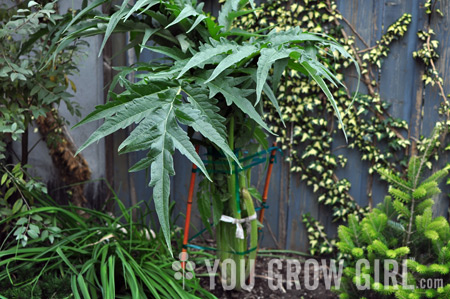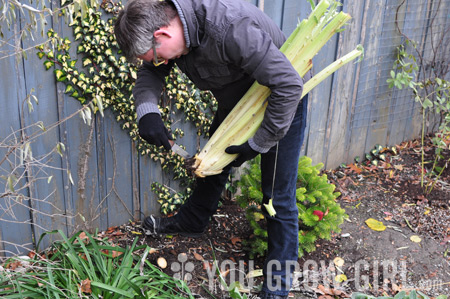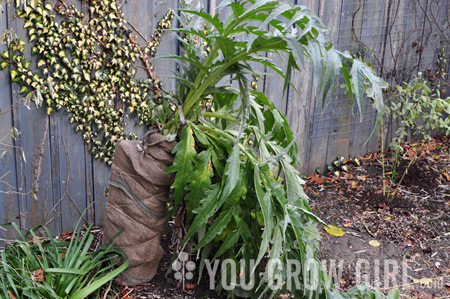
My final Globe and Mail article for the 2010 growing season was on growing and eating cardoon. Cardoon is lesser-known relative of the artichoke that is considered a delicacy in Mediterranean cuisine. Like artichokes it grows into a stately and somewhat dangerous thistle-like plant, but unlike artichokes you eat the stems, not the flower buds. It tastes a lot like artichoke, too.
Back in the spring, I started a few cardoon plants from seed, eventually growing one in my community garden plot and the other at my friend Barry’s.
His spot was ideal, whereas mine fell a bit short. My cardoon grew well enough, but stayed small. The plant at Barry’s got just want it needed and then some. It was really sunny, warm, protected, and in soil that was well watered but very free-draining. Mine was in rich soil with lots of organic matter, but watering was inconsistent (we ran out of water at the garden for a time), and the only spot I could afford was a bit cramped with a taller, more robust plant that shaded out the young cardoon a bit too much.

Last weekend we finally went to Barry’s to harvest the cardoon. It turned out to be the biggest I have ever seen. The yield from one plant was a lot more than I’ve seen in stores or purchased myself. We actually got enough out of it to make 2 batches of cardoon gratin (see recipe below), whereas a typical stalk yields only one.
Many cardoon growers say that going to the trouble of blanching the stems is unnecessary, but now that I have done it, I disagree. For such a large and fibrous plant the stalks we blanched were tender and delicious. I didn’t have to overcook them the way I’ve had to with some of the bunches I have purchased in the past.
I stick by my original assessment. Cardoon is a bit of a pain, and an absolute nightmare to prepare and cook, but it is a stunning plant and a delectable, but acquired taste. What can I say? Some of the best things in life don’t come easy.
——————
Cardoon’s character: It’s a challenge to grow and cook, but uniquely tasty, too
Originally published September 28, 2010.
This year, my love of feral plants that are pointy and slightly dangerous inspired me to try my hand at growing cardoon, a lesser-known relative of the artichoke that is considered a delicacy in Mediterranean cuisine. Cardoons look a lot like artichokes and even produce similar-looking flowers. But while artichokes are all about the delicious, immature flower buds, cardoons are prized for their stalks, which taste something like a smoky artichoke with a trace of licorice.
Finding a place to grow this massive plant in my tiny city plot proved to be the first of many interesting hurdles in the journey from garden to table. Cardoon is like a wild thistle that has been treated with the same magic as Jack’s beanstalk. It’s a rather large (and sharp) plant with a wide girth that requires lots of personal space. With toothy silver leaves that grow into a six-inch-tall rosette, it is a bold and sculptural plant that is worth growing even if you can’t be bothered with the hassle that goes with eating it.
I grew two: one that I put in at my community garden plot and another that I gave to my friend Barry, who decided to grow his as a tropical-look ornamental in a sunny and protected part of his garden. His grew much larger than mine and faster too. I suspect it had to do with the added sun and space he was able to provide since mine was in a cramped spot with a lot of competition for sun and root space.
Despite their Mediterranean origin, cardoons are demanding plants that require lots of soil nutrition and water. Barry and I were on equal ground there – we both fertilized in the spring with organic duck manure and the growing season here in Southern Ontario proved to be perfect for cardoons with ample rain to keep our gardens evenly moist. I started the seeds indoors in April; however, that proved to be quite late for our region and it was touch and go as to whether the plants would be able to catch up and produce a harvest before winter. I’d suggest starting yours at least two to three months before the last spring frost in your area and then transfer the seedlings outside after all danger of frost has passed. Provide lots of nitrogen-based fertilizer and water deeply during a drought to grow the leaves big and succulent for good eating. Do let your plant produce those gorgeous, purplish flower heads. However, do not let them scatter seed or you’ll be gifted with a garden full of baby cardoons next spring.

Now that fall is upon us, Barry and I are taking the final steps to harvesting our crops. Left to their own devices, cardoon stalks are terribly fibrous, bitter and inedible. Like rhubarb, celery and other stem crops, they taste best if you can blanch the plant in the garden to soften it up for eating. This is done by wrapping or covering the bottom foot or so in burlap, landscaping fabric or a cardboard box stuffed with newspapers to keep the sunlight out. It’s easier said than done, as those long leaves are thorny and a pain to get under control. Ask a helper to get underneath the plant and lift the leaves up while you tie it together with string. You’ll have more luck if you sacrifice a few bottom stems first. The plant stays in this mummified state for three to six weeks, at which point you can cut it off at the base with a knife and prepare the stems for eating.
Which brings us to the third and final hurdle: cooking it. Preparing cardoon in the kitchen takes the patience of a saint. This is not easy eating. Blanching in the garden eradicates some of the bitterness, but it is simply not enough to rid the stalks of their dental-floss-like strings.
First, cut the leafy parts and thorns off of the stems with a pair of scissors or a knife. Next, run a vegetable peeler along all sides to remove the thicker, most aggressive fibres. Chop the remaining stems into two-inch pieces and soak in a bowl of cold water with a splash of lemon juice to keep the prepared bits from turning brown as you go.
Finally, parboil the cardoons in salted water until tender – about 20 to 40 minutes. This is the one vegetable that is not going to go to pot if overcooked, so don’t be afraid to go to town with it and then some.
If you’re ready to tackle it, here’s a recipe for cardoon gratin.
Cardoon Gratin
There are several ways to prepare cardoons. North Africans cook it in a tagine alongside meat, preserved lemons and spices, while Northern Italians would not dream of serving a bagna càuda without it. Last fall, I used my first bunch of cardoons in a creamy, herb-infused gratin, because, frankly, what doesn’t taste good with butter and cheese?
Ingredients
- 1 bunch cardoons, chopped into 2-inch lengths and parboiled
- 1½ cups milk
- 1 teaspoon thyme leaves, finely chopped
- 1 clove garlic, crushed
- 2 to 3 slices stale bread or 1 cup breadcrumbs
- ½ cup Parmesan cheese
- 1 teaspoon lemon zest (optional)
- 2 tablespoons butter
- 2 tablespoons flour
- 1½ cups of milk
- Salt and pepper to taste
Method
Preheat the oven to 375 F and prepare the cardoons as outlined, cooking until tender.
Add thyme and garlic to the milk and steep for 15 to 20 minutes. While they’re steeping, make breadcrumbs by chopping the stale bread in a food processor. Mix in Parmesan cheese and lemon zest and season with salt and pepper to taste.
Make a béchamel sauce by heating the butter in a pan until melted. Whisk in the flour and cook for a minute. Remove the garlic clove from the milk, gradually whisk the milk in and continue simmering on medium-low heat to form a thick, smooth sauce. Season with salt and pepper to taste.
Butter the bottom and sides of a casserole dish with a pat of butter or a teaspoon of olive oil. Add the cardoons to the casserole dish and pour the béchamel sauce over top. Cover the cardoons evenly with the breadcrumb mixture and bake in the oven until it is golden brown and bubbling hot straight through (about 20 to 30 minutes).
Serves 2 to 4.
I had NO idea that you could eat this plant !
I do love it for one heck of a “look at me” plant in the garden though .. how could you not be impressed with a giant version of a thistle ? LOL
Joy
This is the first time I’ve heard of the plant cardoon! That’s what I love about your blog… always something new that I can plan for in my garden. :) Thanks! The gratin looks delicious just by looking at what ingredients go into it. If you ever have a pic, please post it since it’s always helpful to have visuals when cooking – especially for whacked out amateur chefs like myself.
well done! sounds like a challenge.. 1st time on your site ive now added u to my favs. its snowing wher i am now but least i can get some different ideas in for next year. ive grown the usual stawbs,potatoes,peas ,carrots and a few herbs,better the yr b4 this yr not as much,(well massive strawberries though)mmmm. glad to have found you x
Thanks for posting this! I’ve been planning on growing these next year and you gave lots of helpful information!